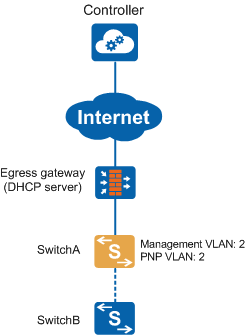pnp startup-vlan receive enable
Function
The pnp startup-vlan receive enable command enables a switch to receive the PnP VLAN negotiation packets sent by its upstream device.
The undo pnp startup-vlan receive enable command disables a switch from receiving the PnP VLAN negotiation packets sent by its upstream device.
By default, a switch is enabled to receive the PnP VLAN negotiation packets from its upstream device.
Usage Guidelines
On a campus network shown in Figure 1, the VLAN for the IP address pool of the DHCP server is not VLAN 1 and SwitchB is newly connected to the network. After SwitchB is connected to the network, it uses the management VLAN 1 to send a request packet to the DHCP server to obtain the NETCONF enabling configuration, IP address, and information of controller. The VLAN for the IP address pool of the DHCP server is not VLAN 1. As a result, SwitchB cannot obtain the related information.
To address the problem, configure PnP VLAN auto-negotiation on SwitchA. After SwitchB starts, SwitchA transmits the PnP VLAN ID to SwitchB through PnP VLAN auto-negotiation, so that SwitchB can use the PnP VLAN to obtain the related information from the DHCP server.
- If NETCONF is enabled on SwitchA:
- SwitchA has registered with iMaster NCE-Campus successfully.
- iMaster NCE-Campus has delivered a PnP VLAN ID to SwitchA, and the configuration file contains the pnp startup-vlan vlan-id command or SwitchA has negotiated a PnP VLAN ID with its upstream device.
- iMaster NCE-Campus has delivered to SwitchA the function of transmitting the PnP VLAN ID to its downstream device, and the configuration file contains the pnp startup-vlan send enable command.
- SwitchA is enabled to send LLDP packets containing PnP VLAN information to its downstream device. This function is enabled by default. If the configuration file contains the undo lldp tlv-enable legacy-tlv pnp startup-vlan command, the function of sending LLDP packets containing the PnP VLAN ID to the downstream device is disabled. You can enable the function on iMaster NCE-Campus.
- If NETCONF is not enabled on SwitchA:
- SwitchA has a PnP VLAN ID configured using the pnp startup-vlan vlan-id command.
- The pnp startup-vlan send enable command has been configured on SwitchA to transmit PnP VLAN information to its downstream device.
- SwitchA is enabled to send LLDP packets containing PnP VLAN information to its downstream device. This function is enabled by default. If the configuration file contains the undo lldp tlv-enable legacy-tlv pnp startup-vlan command, the function of sending LLDP packets containing the PnP VLAN ID to the downstream device is disabled. You can run the lldp tlv-enable legacy-tlv pnp startup-vlan command to enable this function.
SwitchB can obtain the PnP VLAN ID transmitted by SwitchA only after SwitchB is enabled to receive the PnP VLAN negotiation packets sent by its upstream device. This function is enabled by default. If the configuration file contains the undo pnp startup-vlan receive enable command, the function of receiving the PnP VLAN negotiation packets sent by the upstream device is disabled. You can enable the function on controller.
The function of transmitting the PnP VLAN ID to the downstream device and the PnP VLAN ID can be preconfigured on controller and delivered to a switch after the switch has registered with controller. If the switch does not register with controller, perform preconfiguration on the switch.
